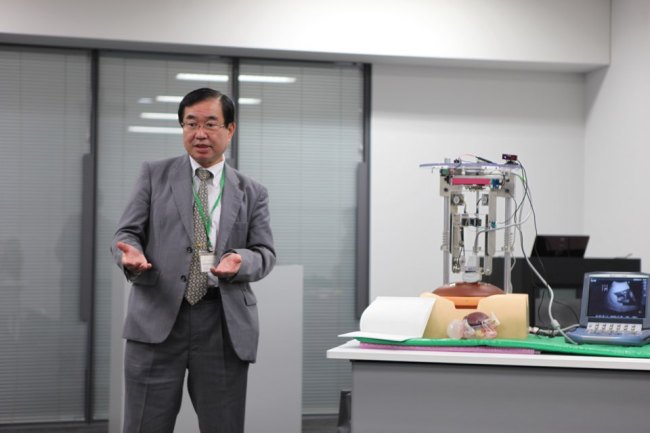The Korea Herald is publishing a series of articles on the moves made by the companies and governments of South Korea, China and Japan in entering the new industry 4.0 era. This is the fourth installment. -- Ed.
 |
Waseda University professor Hiroshi Yamakawa explains Japan’s robotic technologies at Future Robotics on Nov. 11 in Tokyo. (Park Ga-young/The Korea Herald) |
TOKYO -- For the Tokyo Olympics in 1964, Japan unveiled the Shinkansen bullet train, broadcast live TV images via satellite and used computers to record statistics, the first such attempt for the global games.
Now, over five decades later and four years away from another Olympic Games, Japan is gearing up to showcase its cutting-edge information and communications technology during the 2020 Tokyo Olympics.
“For the next Olympics, Japan will show off its top notch autonomous driving technologies,” Hwang Kee-yeon, vice president of Hongik University, said at a forum on autonomous driving in December in Seoul.
In 2020, Tokyo will have autonomous taxi services provided by Tokyo-based firm Robot Taxi -- and it will not be the only thing Japan wants to showcase by 2020.
Earlier this year, Japan unveiled a plan to invest a total of 26 trillion yen ($222 billion) over the next five years -- or 1 percent of the country’s gross domestic production each year -- for science and technologies focusing on future technology related to the industrial revolution.
“Based on big data building on IoT technology, we can figure out what would be good services in the future and it would create new industries and bring about a revolution,” said Masayoshi Watanabe, director of the Industrial Science and Technology Policy Division at the Ministry of Economy, Trade and Industry in Japan, emphasizing that the new industrial revolution is critical for Japan’s economic growth.
Japan has been battling deflation for two decades and lost its status as the world’s second-largest economy to China in 2010.
Japan’s Prime Minister Abe Shinzo has put innovation at the heart of the country’s revitalization strategy. One such example is Japan’s Robot Strategy, which was announced in 2015. It declares the next five years as a time for robotics innovation. According to the plan, the government will invest about 100 billion yen in robotics-related projects with a vision to expand the robotics market by 20 times of its current market value.
Japan has been quick to introduce robots that incorporate robotic technologies to various industries and daily lives.
In recent years, Japan has introduced a robot-powered bagging system, a robot that took a university entrance exam (although it failed to pass), a baby robot for lonely couples, an insurance selling robot and a concierge robot.
These robots reflect Japan’s efforts to solve socioeconomic problems such as the country’s low birthrate and aging population via robot innovation. The number of new births in the country is expected to be below 1 million for the first time since records began in 1899, and more than a quarter of Japan’s population is now 65 years or older.
“We focus on developing robots that could contribute to human society -- such as rescue robots, construction robots and health care robots,” said Hiroshi Yamakawa, a professor at Waseda University and the head of robot research institute Future Robotics Organization. The university, which has been building its reputation as a leading robotic research institution since the 1960s, will now focus on commercializing its robots with a company called Future Robotics.
To surprise the world with a futuristic city by 2020, Japan needs to work on other areas of the industrial revolution such as artificial intelligence, the Internet of Things and big data, according to Japan’s government officials and business people.
Between 2008 and 2013, most published research papers on AI came from western countries and China while Japan contributed only 2 percent of the total AI research output.
With its eye on 2020, however, Japan is speeding up its innovation in these areas with generous investments including a new AI research center established in 2015.
By Park Ga-young (
gypark@heraldcorp.com)








![[Today’s K-pop] Blackpink’s Jennie, Lisa invited to Coachella as solo acts](http://res.heraldm.com/phpwas/restmb_idxmake.php?idx=644&simg=/content/image/2024/11/21/20241121050099_0.jpg)